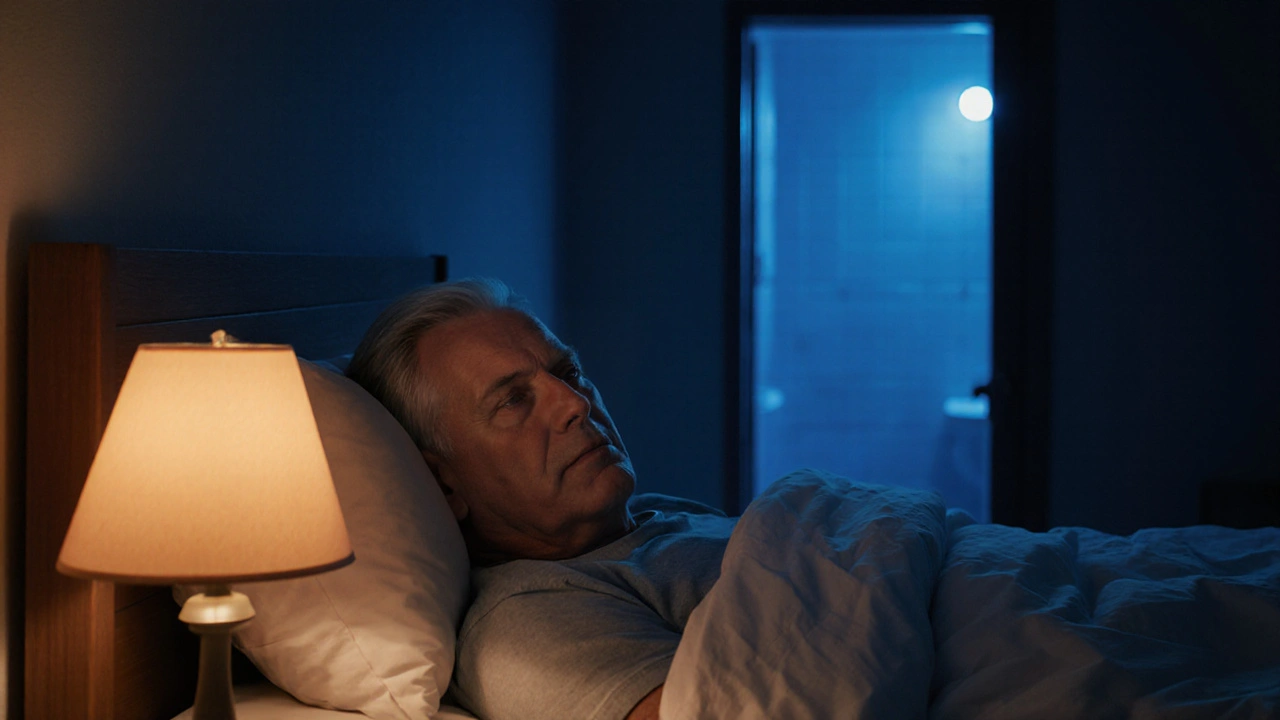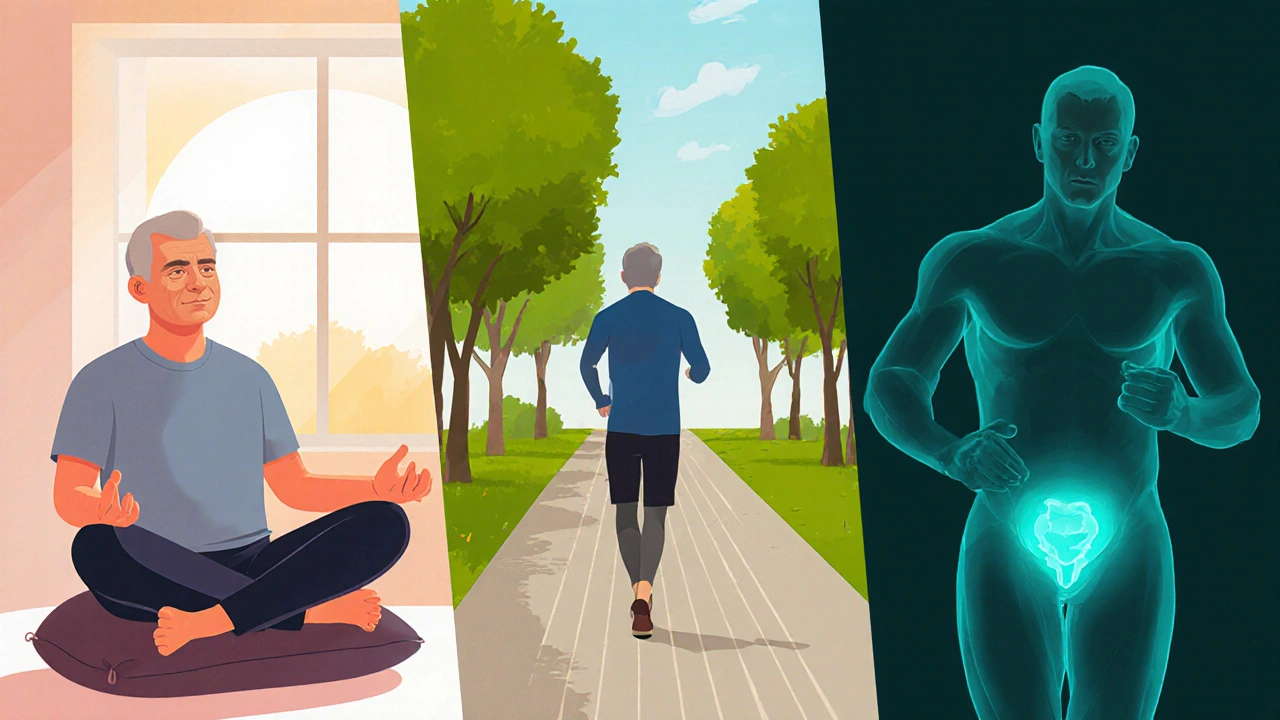Managing Stress and Anxiety Linked to an Enlarged Prostate
 Oct, 9 2025
Oct, 9 2025
Stress Management for Enlarged Prostate
Assess Your Current Stress Level
Rate how much stress you're experiencing due to prostate symptoms.
Track Your Daily Habits
Check off the habits you've completed today to manage stress and improve prostate health.
Your Progress Summary
Today's Completion Rate: 0%
Stress Level Change: 0
Recommendation: Keep up the good work!
Enlarged Prostate is a non‑cancerous enlargement of the prostate gland, medically known as Benign Prostatic Hyperplasia (BPH) that affects up to 50% of men over 60. While the physical symptoms-frequent urination, nighttime trips to the bathroom, weak stream-are well documented, the mental side often gets ignored. Men start worrying about bed‑wetting, losing independence, or even fearing cancer, and that anxiety can quickly turn into chronic stress. This article breaks down practical steps you can take today to calm the mind, keep the body moving, and protect prostate health.
Key Takeaways
- Identify the specific stressors that come with BPH and address them directly.
- Adopt three core lifestyle pillars: movement, mindful breathing, and nutrition.
- Use proven mind‑body tools-mindfulness, aerobic exercise, and CBT-to lower cortisol.
- Know when professional help is needed and what treatments are safe alongside BPH medication.
- Create a simple daily checklist that takes less than 15 minutes.
Why BPH Triggers Stress and Anxiety
First, understand the feedback loop. Physical irritation of the bladder sends signals to the brain that you need to go. When the urge repeats night after night, the brain starts interpreting it as a threat to sleep, leading to Stress. Chronic stress releases cortisol, which can worsen inflammation in the prostate-a tiny but real vicious cycle. Anxiety adds a mental overlay: thoughts like “What if I can’t make it to work because I’m constantly up?” fuel worry and reduce quality of life. Recognising the loop is the first step to breaking it.
Step 1: Re‑frame Your Thoughts with Mindfulness
The simplest entry point is Mindfulness meditation. Studies from 2023 show an 18% reduction in perceived stress after eight weeks of 10‑minute daily sessions. The practice teaches you to notice the urge without reacting-observe the bladder’s signal, label it (“I feel the need to pee”), and let it pass. This habit reduces the brain’s alarm response, lowering cortisol.
- Find a quiet spot, sit upright, and set a timer for 5minutes.
- Focus on the breath; inhale for four counts, exhale for six.
- When the urge pops up, mentally note it and return to breathing.
Do this twice a day-once in the morning and once before bed-to train the nervous system.
Step 2: Move Your Body with Aerobic Exercise
Regular Aerobic exercise (walking, cycling, swimming) boosts circulation to the pelvic region and burns excess calories that can worsen BPH symptoms. A 2022 meta‑analysis of 14 trials found that men who logged 150minutes of moderate cardio each week reported a 22% drop in anxiety scores.
- Start with a 10‑minute brisk walk after dinner-this also helps regulate sleep.
- Gradually increase to 30‑minute sessions, five days a week.
- Mix in intervals (30seconds faster, 90seconds slower) to keep it interesting.
Remember, the goal isn’t a marathon; it’s a consistent habit that tells your body, “I’m in control.”

Step 3: Strengthen the Pelvic Floor
Pelvic floor exercises (often called Kegels) directly improve bladder control. Tightening the muscles for three seconds, then relaxing for five, repeated ten times, can reduce nighttime trips by up to 30% after six weeks.
- Locate the muscles by stopping urine mid‑stream-don’t make a habit of doing this while peeing.
- Do the set while watching TV or sitting at a desk.
- Track progress in a simple notebook.
Combine these with aerobic work for a comprehensive approach.
Step 4: Feed Your Body the Right Nutrients
Diet plays a quiet yet powerful role. Two nutrients stand out for prostate health and stress reduction:
- Omega‑3 fatty acids-found in fatty fish, flaxseed, and walnuts-lower inflammatory markers by 15% on average.
- Dietary fiber-whole grains, beans, and berries-helps regulate estrogen levels that can affect prostate growth.
Aim for two servings of oily fish per week and at least 25grams of fiber daily. Swap processed snacks for a handful of almonds or a piece of fruit.
Step 5: Improve Sleep Hygiene
Sleep deprivation spikes cortisol, worsening both stress and BPH symptoms. Follow these night‑time rules:
- Limit caffeine after 2p.m.
- Keep the bedroom cool (around 18°C) and dark.
- Use a “no‑screen” window 30minutes before bed; read a paper book instead.
Even a 30‑minute reduction in wake‑after‑sleep time can lower anxiety scores noticeably.
Step 6: Consider Professional Mental‑Health Support
When self‑help isn’t enough, Cognitive Behavioral Therapy (CBT) offers a structured way to challenge catastrophizing thoughts about BPH. A 2024 randomized trial showed a 35% improvement in quality‑of‑life scores after 12 weekly CBT sessions.
You don’t need a psychiatrist for all cases-licensed psychologists, counsellors, or even tele‑health platforms can deliver CBT modules at a lower cost.

Quick Comparison of Three Core Techniques
| Technique | Average Time Needed per Day | Evidence‑Based Effectiveness | Ease of Starting |
|---|---|---|---|
| Mindfulness meditation | 5‑10min | 18% reduction in perceived stress (8‑week trials) | Very easy - no equipment |
| Aerobic exercise | 150min/week (≈30min ×5) | 22% drop in anxiety scores (meta‑analysis) | Moderate - need safe space to move |
| CBT (guided) | 1‑hour session weekly | 35% improvement in QoL (2024 RCT) | Requires professional setup |
Putting It All Together: A 7‑Day Starter Plan
Below is a simple checklist that mixes the highest‑impact actions. Each item takes under 15minutes, so you can fit it into a busy life.
- Morning: 5‑minute mindfulness while drinking water.
- Mid‑morning: 10‑minute brisk walk.
- Lunch: Eat a salad with walnuts (Omega‑3 boost).
- Afternoon: 3 sets of pelvic floor contractions (10seconds each).
- Evening: 20‑minute moderate‑intensity cardio (bike or swim).
- Pre‑bed: 5‑minute body‑scan meditation; avoid screens.
- Weekly: Book a tele‑health CBT session if anxiety feels unmanageable.
Track how often you wake up at night, your mood on a 1‑10 scale, and any changes in urinary patterns. Small improvements accumulate quickly.
When to Seek Medical Advice Beyond Lifestyle
If you notice any of the following, contact your urologist promptly:
- Blood in urine or semen.
- Sudden inability to start or stop the stream.
- Painful urination that doesn’t improve with simple measures.
- Persistent anxiety that interferes with work or relationships despite self‑care.
Your doctor can discuss safe medication options-alpha‑blockers, 5‑α‑reductase inhibitors-and how they interact with any supplement you take.
Bottom Line
Managing stress and anxiety tied to an enlarged prostate isn’t about a single miracle cure. It’s a blend of mental‑training, movement, nutrition, and professional support. By tackling the problem on three fronts-mind, body, and medical-you lower cortisol, improve bladder control, and keep quality of life high.
Frequently Asked Questions
Can stress actually make my enlarged prostate worse?
Yes. Chronic stress raises cortisol, which can increase inflammation around the prostate. Over time, this may intensify urinary symptoms and feed a feedback loop of anxiety and physical discomfort.
How long does it take to see results from mindfulness?
Most people notice a calmer mind after 2‑3 weeks of consistent 5‑minute daily practice. Studies using eight‑week programs report measurable drops in perceived stress.
Is it safe to combine omega‑3 supplements with BPH medication?
Generally, yes. Omega‑3s do not interact with common BPH drugs like tamsulosin or finasteride. However, always tell your doctor about any supplement you start.
Do pelvic floor exercises work for older men?
Research shows men over 65 can improve bladder control by 20‑30% after six weeks of regular Kegel training, provided they perform the exercises correctly.
When should I consider professional therapy?
If anxiety interferes with daily activities, sleep, or relationships for more than a month, or if you notice depressive thoughts, it’s time to schedule a CBT or counselling session.
cris wasala
October 9, 2025 AT 21:54Hey man you’re not alone this is a common thing and the steps you listed are solid-keep at it!
Tyler Johnson
October 10, 2025 AT 14:34I really appreciate the thoroughness of the guide and the way it balances both mental and physical strategies; it shows a genuine respect for the complexities that men with BPH face. The inclusion of mindfulness, aerobic activity, and pelvic floor training reads like a holistic prescription that many could benefit from. While some readers may find the 150‑minute weekly cardio target a bit ambitious, it’s a realistic goal once a routine is established. Moreover, the emphasis on nutrition, especially omega‑3s and fiber, adds an evidence‑based nutritional pillar that fortifies the overall plan. It’s also helpful that the article outlines concrete steps for tracking progress, because data can motivate continued adherence. Overall, the tone feels encouraging without being patronizing, which is a delicate balance to strike.
Annie Thompson
October 11, 2025 AT 07:14The anxiety that comes with an enlarged prostate can feel like a shadow that never leaves you. Every night you wake up, you wonder if you’ll make it through the rest of the day. The article reminds you that this fear is not just in your head but tied to real physiological stress. It points out that cortisol can worsen inflammation around the prostate. It also tells you that breaking the loop starts with awareness. Mindfulness meditation is presented as a way to notice the urge without jumping to panic. Even a five‑minute session can reset how your brain reacts. Aerobic exercise is another pillar that pumps blood and clears tension. Walking, cycling, or swimming can be done at any age. Pelvic floor exercises, though sometimes awkward, actually strengthen the muscles that control flow. Nutrition isn’t just a buzzword; omega‑3s and fiber have research behind them. Sleep hygiene, like limiting caffeine after noon, can shrink those nighttime bathroom trips. The checklist format makes it easy to see daily progress. Professional help such as CBT is offered as a safety net. In short, the guide stitches together a tapestry of small actions that together can lift the weight of worry.
Parth Gohil
October 11, 2025 AT 23:54The interplay between the sympathetic nervous system and pelvic floor musculature is crucial; by modulating sympathetic output through aerobic conditioning you can actually dampen detrusor overactivity. Incorporating mindfulness engages the parasympathetic branch which counterbalances stress‑induced catecholamine spikes. When you combine that with a diet rich in eicosapentaenoic acid you’re addressing the inflammatory cascade at a molecular level. Overall, the protocol you outlined harmonizes autonomic regulation with structural support.
VAISHAKH Chandran
October 12, 2025 AT 16:34Only the truly enlightened grasp the depth of this regimen.
Pat Merrill
October 13, 2025 AT 09:14Oh sure the prostate will thank you for a 5‑minute meditation, definatly like a thank‑you note from a lazy cat. It’s funny how we treat our bodies like a broken laptop and think a reboot will fix everything. The whole thing sounds like a self‑help book written by a yoga‑obsessed philosopher. But hey if it keeps the anxiety at bay, why not give it a shot.
Vicki Roth
October 14, 2025 AT 01:54The checklist approach is a practical way to visualize progress without overwhelming the user.
Vishal Bhosale
October 14, 2025 AT 18:34Your list is okay but nothing groundbreaking.
Garima Gauttam
October 15, 2025 AT 11:14If you think mindfulness alone solves BPH then you’re buying a cheap miracle.
Georgia Nightingale
October 16, 2025 AT 03:54Let me tell you, the intersection of urological health and mental well‑being is a narrative that has been ignored for far too long. When men hear the term BPH they immediately think of swollen tissue and ignore the cascade of cortisol that follows. Cortisol, that sneaky stress hormone, does not just sit idle; it actively fuels inflammatory pathways that exacerbate urinary urgency. Therefore, any comprehensive protocol must address the endocrine axis as vigorously as it tackles the mechanical obstruction. Your article rightly points out mindfulness, yet many readers underestimate the neuroplastic changes that sustained meditation can induce. Neuroplasticity, the brain’s ability to rewire itself, can dampen the hypervigilant bladder signals that keep men awake at night. Aerobic exercise, on the other hand, is not merely a calorie‑burning activity; it improves endothelial function and enhances pelvic perfusion. Improved perfusion means the prostate receives better blood flow, which paradoxically can reduce hyperplasia progression. Pelvic floor training, often dismissed as a men’s health footnote, actually strengthens the sphincteric closure mechanism, reducing leak episodes. Nutritionally, omega‑3 fatty acids act as precursors to resolvins, molecules that actively resolve inflammation rather than just preventing it. Fiber, while championed for digestive health, also modulates estrogen metabolism, a subtle but important factor in prostate growth. Sleep hygiene, as you noted, is the unsung hero; sleep deprivation spikes norepinephrine, another stress mediator that can aggravate symptoms. If any part of this regimen feels onerous, remember that incremental adoption yields compounding benefits over months, not weeks. Professional therapy, especially CBT, provides cognitive tools to reframe catastrophic thoughts that otherwise spiral into psychosomatic worsening. In sum, the article stitches together a multifaceted tapestry that, if followed, can transform the lived experience of countless men.
Chris Kivel
October 16, 2025 AT 20:34Great points everyone keep sharing the love and remember progress is a marathon not a sprint
sonia sodano
October 17, 2025 AT 13:14Honestly I think all this hype about mindfulness is just a trendy excuse to avoid real medical treatment.
Praveen Kumar BK
October 18, 2025 AT 05:54While I respect the enthusiasm, let’s be clear: “mindfulness” is not a cure and the phrase “avoid real medical treatment” is misleading; proper care should never be dismissed.
Viji Sulochana
October 18, 2025 AT 22:34hey i think u meant “proper care should never be dismissed” not “proper care should never be discounted” lol
Stephen Nelson
October 19, 2025 AT 15:14Oh wow, because ignoring decades of clinical research is the new way to feel brave, right?
Fredric Chia
October 20, 2025 AT 07:54Empirical evidence suggests the proposed regimen yields modest symptom reduction; however, statistical significance remains marginal.
Hope Reader
October 21, 2025 AT 00:34Sure, because a 5‑minute breathing exercise will magically fix your night‑time trips 😂
Marry coral
October 21, 2025 AT 17:14Stop whining and just do the exercises.
Emer Kirk
October 22, 2025 AT 09:54Sound advice.
George Gritzalas
October 23, 2025 AT 02:34Wow, the dramatic flair in this thread could win an Oscar for best over‑the‑top medical drama, bravo!